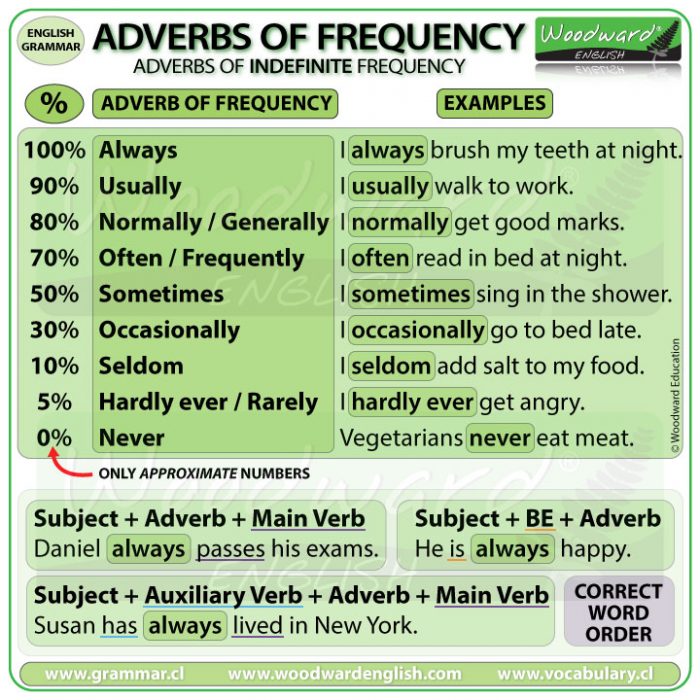Adverbs of Frequency
Always, usually, normally, generally, often, frequently, sometimes, occasionally, seldom, hardly ever, rarely, and never.
These are all adverbs and they describe how frequently we do an activity or the frequency of habits.
These are called Adverbs of Frequency or more specifically Adverbs of Indefinite Frequency. (Indefinite because it is NOT a specific frequency like three times a week, once a month, etc.)
To help you understand when to use each adverb of frequency, I will add some approximate numbers (percentages of frequency or possibility of it happening) to give you a general idea of the frequency associated with each adverb.
- 100% always
- 90% usually
- 80% normally / generally
- 70% often / frequently
- 50% sometimes
- 30% occasionally
- 10% seldom
- 5% hardly ever / rarely
- 0% never
IMPORTANT: The percentages that appear on the left are only approximate numbers to give you a general idea of the frequency associated with each adverb.
Let’s look at each adverb of frequency more in detail…
ALWAYS
When something happens 100% of the time, we use the adverb ALWAYS.
- I always brush my teeth at night.
This means that without exception 100% of the time I will brush my teeth at night before going to bed.
NEVER
What is the opposite of ALWAYS? … NEVER, which is 0% of the time.
- Vegetarians never eat meat.
This means there is a zero percent possible of this happening. The frequency is zero.
SOMETIMES
What adverb do we use when something happens half the time and the other half of the time it doesn’t happen?
When something has about a 50% frequency of happening. We use the adverb SOMETIMES.
- I sometimes sing in the shower.
This means half the time I am in the shower I sing, and half the time I don’t sing… I sometimes sing in the shower.
HARDLY EVER / RARELY
What can we use if we almost never do something? It’s not zero percent but maybe 5% possibility of it happening.
In this case we use the adverbs HARDLY EVER or RARELY.
- I hardly ever get angry.
OR you can say…
- I rarely get angry
They both mean the same thing.
This means there is a VERY small chance of it happening but it is almost never.
I hardly ever get angry. It usually only happens if you steal my chocolate from the fridge. Other than that, nothing else annoys me.
Let’s quickly look at the other adverbs of frequency.
USUALLY
USUALLY is when something happens around 90% of the time. It is almost always.
- I usually walk to work.
Yes, I live close to my place of work so I usually walk there.
NORMALLY / GENERALLY
NORMALLY or GENERALLY happen around 80% of the time.
- I normally get good marks.
Yes, about 80% of the time my marks are good, the rest of the time… they are excellent!
OFTEN / FREQUENTLY
When something has a frequency of around 70%, we use the adverbs OFTEN or FREQUENTLY
OFTEN can be pronounced two ways:
- By pronouncing the T … “OFTEN” … or
- By not pronouncing the T …”OFFEN” (Never write “Offen”)
Both forms are correct and depend on where you live.
Our examples of these adverbs are:
- I often read in bed at night.
which is the same as:
- I frequently read in bed at night.
The adverb OFTEN is more common than using the word FREQUENTLY.
OCCASIONALLY
The adverb Occasionally is at about 30% frequency.
- I occasionally go to bed late.
Yes, this happens on Friday and Saturday night. I occasionally go to bed late.
SELDOM
And the adverb Seldom is at around 10% frequency.
- I seldom add salt to my food.
Which means it is not common or not often that I add salt.
The adverbs Seldom, hardly ever, rarely, and never all have a negative meaning.
Adverbs of Frequency – Word Order
Let’s look at word order when we use adverbs of frequency.
In general, the adverb of frequency goes before the main verb.
The order is: Subject + Adverb + Main Verb
Let’s look at this sentence…
- I read in bed at night.
If I want to let you know about the frequency I do this, the frequency that I read in bed, then I need to use an adverb.
The main verb is READ, so we put the adverb before the verb READ…
- I often read in bed at night.
Another example:
- Daniel always passes his exams.
The main verb is PASSES so we put the adverb before it.
- They never speak Spanish in class.
The main verb is SPEAK so the adverb of frequency goes before it.
Adverbs of Frequency – Word Order with Auxiliary Verbs
When there is an auxiliary verb such as has, have, must, might, will, can, should, would, etc. followed by a main verb, then the adverb goes between them both.
Subject + Auxiliary Verb + Adverb + Main Verb
- I have done my homework.
HAVE is the auxiliary verb and DONE is the main verb so we put the adverb of frequency in the middle:
- I have always done my homework.
You can see it is the same rule as before, the adverb goes before the main verb. Just remember to put it after the auxiliary verb.
Look at this sentence:
- Susan has lived in New York.
HAS is the auxiliary verb and LIVED is the main verb so we put the adverb of frequency in the middle:
- Susan has always lived in New York.
Look at this example:
- I have never eaten dog food.
The adverb NEVER goes between the auxiliary verb HAVE and the main verb EATEN.
- I have never eaten dog food… that I know of.
Adverbs of Frequency – Word Order with TO BE
Of course in English there is always an exception and this happens with the verb TO BE.
When we want to use an adverb with the verb TO BE, then the order is:
Subject + TO BE + Adverb
Look at this sentence:
- I am busy at work.
AM is a form, or conjugation, of the verb TO BE so we put the adverb after it.
- I am normally busy at work.
We cannot say “I normally am busy at work.” NO, this is NOT correct.
- He is always happy.
Again, the adverb is after the form of To Be.
- They are sometimes late.
The adverb SOMETIMES comes after the verb ARE which is a form of TO BE.
Adverbs of frequency at the beginning of a sentence
We have just seen the common position of adverbs of frequency within a sentence.
But, it is also possible to place SOME adverbs at the beginning of a sentence.
These adverbs include: usually, normally, frequently, generally, occasionally, and sometimes.
Look at these examples:
- Occasionally I have pancakes for breakfast.
OR you can put the adverb between the subject and main verb:
- I occasionally have pancakes for breakfast.
Both sentences are correct.
- Normally our English class is in the morning.
- Sometimes they take a bus to work.
But be careful with always, hardly ever, seldom, rarely, and never …. Do NOT put them at the beginning of the sentence.
- Always I get up early. This is NOT correct.
We need to put ALWAYS before the main verb…
- I always get up early. (CORRECT)
The exception to this is when we are using ALWAYS or NEVER in the IMPERATIVE to give orders or instructions.
We will see more about this in another lesson.
Next activity
You might want to watch our other video about Adverbs of DEFINITE frequency.
Summary Chart

I hope you found this English lesson about adverbs of frequency useful. If you did, please let other people know about us!
Have an awesome day!
